Showing Spotlights 169 - 176 of 201 in category All (newest first):
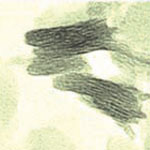 Traditional anode materials for lithium-ion batteries, like graphite, have a fairly low storage capacity and release rate, so finding alternatives is key to making batteries that last longer and produce more power. Titanium dioxide is regarded as one of the ideal candidates for high-rate anode materials, owing not only to its structural characteristics and special surface activity, but also to its low cost, safety, and relatively low environmental impact. Researchers in Singapore have developed a facile system to fabricate sandwich-like carbon-supported stacked titanium dioxide nanosheets, in which carbon pillars create open channels for fast lithium ion diffusion and the ultrathin framework renders the storage of lithium almost exclusively on the surface. This work provides a new route to design the electrode materials for quick-charging lithium ion batteries.
Traditional anode materials for lithium-ion batteries, like graphite, have a fairly low storage capacity and release rate, so finding alternatives is key to making batteries that last longer and produce more power. Titanium dioxide is regarded as one of the ideal candidates for high-rate anode materials, owing not only to its structural characteristics and special surface activity, but also to its low cost, safety, and relatively low environmental impact. Researchers in Singapore have developed a facile system to fabricate sandwich-like carbon-supported stacked titanium dioxide nanosheets, in which carbon pillars create open channels for fast lithium ion diffusion and the ultrathin framework renders the storage of lithium almost exclusively on the surface. This work provides a new route to design the electrode materials for quick-charging lithium ion batteries.
Jan 21st, 2011
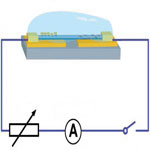 Nanotechnology researchers working on self-powered nanodevices - nanoscale systems that scavenge energy from their surrounding environment - have been experimenting with various power sources ranging from piezoelectric systems to sound. However, the most abundant energy available in biosystems is chemical and biochemical energy, such as glucose. Researchers in China have now reported a nanowire-based biofuel cell based on a single proton conductive polymer nanowire for converting chemical energy from biofluids into electricity, using glucose oxidase and laccase as catalyst. The output of this biofuel cell is sufficient to drive pH, glucose or photon sensors. The high output power, low cost and easy fabrication process, large-scale manufacturability, high 'on-chip' integrability and stability demonstrates its great potential for in vivo biosensing.
Nanotechnology researchers working on self-powered nanodevices - nanoscale systems that scavenge energy from their surrounding environment - have been experimenting with various power sources ranging from piezoelectric systems to sound. However, the most abundant energy available in biosystems is chemical and biochemical energy, such as glucose. Researchers in China have now reported a nanowire-based biofuel cell based on a single proton conductive polymer nanowire for converting chemical energy from biofluids into electricity, using glucose oxidase and laccase as catalyst. The output of this biofuel cell is sufficient to drive pH, glucose or photon sensors. The high output power, low cost and easy fabrication process, large-scale manufacturability, high 'on-chip' integrability and stability demonstrates its great potential for in vivo biosensing.
Jan 3rd, 2011
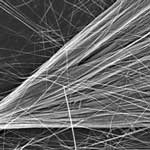 Traditionally, battery materials have been studied with bulk quantities in a complex environment with both active electrode components and many other supporting materials such as polymer binders and conductive additives. Although nanomaterials have been found to be able to improve battery performance, the complexity has made it hard to tell clearly about their advantages. Moreover, it is difficult to know whether fast capacity fading is due to the intrinsic nature of the transport property changes of active nanomaterials or an extrinsic reason from their interactions with the supporting materials, if all of them are studied together. The goal to understand the intrinsic reason of active material capacity fading has motivated a group of researchers to design single nanowire electrochemical devices as an extremely simplified model system to push the fundamental limits of the nanowire materials for energy storage applications. The result is a powerful and effective diagnostic tool for property degradation of lithium ion based energy storage devices.
Traditionally, battery materials have been studied with bulk quantities in a complex environment with both active electrode components and many other supporting materials such as polymer binders and conductive additives. Although nanomaterials have been found to be able to improve battery performance, the complexity has made it hard to tell clearly about their advantages. Moreover, it is difficult to know whether fast capacity fading is due to the intrinsic nature of the transport property changes of active nanomaterials or an extrinsic reason from their interactions with the supporting materials, if all of them are studied together. The goal to understand the intrinsic reason of active material capacity fading has motivated a group of researchers to design single nanowire electrochemical devices as an extremely simplified model system to push the fundamental limits of the nanowire materials for energy storage applications. The result is a powerful and effective diagnostic tool for property degradation of lithium ion based energy storage devices.
Sep 27th, 2010
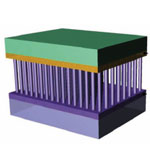 Imagine cellular phones that can be charged during conversations and sound-insulating walls near highways that generate electricity from the sound of passing vehicles. A number of approaches for self-powering systems by scavenging energy from environments using photovoltaic, thermoelectric, and piezoelectric phenomena have been intensively explored. Among them, very recent innovative research has been intensively carried out to convert external mechanical stimuli such as body movements, heartbeat, blood flow, and ultrasonic wave into electricity, resulting in piezoelectric power-driven wireless self-powered systems. Such a piezoelectric power generation aims to capture the normally wasted energy surrounding a system and converts it into usable energy for operating electrical devices. New work by a nanotechnology research team in Korea has now demonstrated that it is possible to use sound as a power source to drive nanogenerators based on piezoelectric nanowires.
Imagine cellular phones that can be charged during conversations and sound-insulating walls near highways that generate electricity from the sound of passing vehicles. A number of approaches for self-powering systems by scavenging energy from environments using photovoltaic, thermoelectric, and piezoelectric phenomena have been intensively explored. Among them, very recent innovative research has been intensively carried out to convert external mechanical stimuli such as body movements, heartbeat, blood flow, and ultrasonic wave into electricity, resulting in piezoelectric power-driven wireless self-powered systems. Such a piezoelectric power generation aims to capture the normally wasted energy surrounding a system and converts it into usable energy for operating electrical devices. New work by a nanotechnology research team in Korea has now demonstrated that it is possible to use sound as a power source to drive nanogenerators based on piezoelectric nanowires.
Sep 23rd, 2010
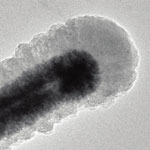 Most of today's lithium-ion batteries rely on anodes made from graphite, a form of carbon. There are several candidate electrodes to replace graphite as the anode for lithium-ion batteries. Such electrodes like silicon or tin have very high capacities but suffer from poor efficiency and cyclic stability as they experience large volume change and particle pulverization during repeated cycling. Silicon-based anodes, for instance, theoretically offer as much as a ten-fold capacity improvement over graphite, but silicon-based anodes have so far not been stable enough for practical use. Researchers have now used the macromolecular structure of self-assembled Tobacco mosaic virus as templates to fabricate stable three-dimensional current collectors for high power and high energy density Li-ion batteries.
Most of today's lithium-ion batteries rely on anodes made from graphite, a form of carbon. There are several candidate electrodes to replace graphite as the anode for lithium-ion batteries. Such electrodes like silicon or tin have very high capacities but suffer from poor efficiency and cyclic stability as they experience large volume change and particle pulverization during repeated cycling. Silicon-based anodes, for instance, theoretically offer as much as a ten-fold capacity improvement over graphite, but silicon-based anodes have so far not been stable enough for practical use. Researchers have now used the macromolecular structure of self-assembled Tobacco mosaic virus as templates to fabricate stable three-dimensional current collectors for high power and high energy density Li-ion batteries.
Aug 24th, 2010
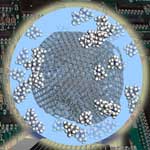 Supercapacitors, also called electric double layer capacitors (EDLC), store energy in two closely spaced layers with opposing charges and offer fast charge/discharge rates and the ability to sustain millions of cycles. It is frequently stated that supercapacitors bridge the gap between batteries and electrolytic ('conventional') capacitors, but contemporary devices have a lower specific energy than Li-ion batteries and are orders of magnitude slower than electrolytic capacitors. A research team has now shown that by moving from porous carbon with a network of pores inside particles as electrode material to exposed surfaces of nanostructured carbon onions of 6-7 nm diameter, it is possible to reach the discharge rate (power) of electrolytic capacitors, but with volumetric capacitance about four orders of magnitude higher. Moreover, observed discharge rates up to 200 V/second are about three orders of magnitude higher than conventional supercapacitors.
Supercapacitors, also called electric double layer capacitors (EDLC), store energy in two closely spaced layers with opposing charges and offer fast charge/discharge rates and the ability to sustain millions of cycles. It is frequently stated that supercapacitors bridge the gap between batteries and electrolytic ('conventional') capacitors, but contemporary devices have a lower specific energy than Li-ion batteries and are orders of magnitude slower than electrolytic capacitors. A research team has now shown that by moving from porous carbon with a network of pores inside particles as electrode material to exposed surfaces of nanostructured carbon onions of 6-7 nm diameter, it is possible to reach the discharge rate (power) of electrolytic capacitors, but with volumetric capacitance about four orders of magnitude higher. Moreover, observed discharge rates up to 200 V/second are about three orders of magnitude higher than conventional supercapacitors.
Aug 19th, 2010
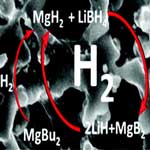 The main obstacle to building a hydrogen economy is the lack of efficient hydrogen storage. The research conducted in the hydrogen storage scientific community is aimed towards mobile applications. Hydrogen is a gas at ambient conditions and takes up a lot of space. For stationary storage facilities, for which available space is not an issue, hydrogen gas can be kept in large tanks at moderate pressures using already known technology. However, in order to utilize hydrogen for mobile applications i.e. to produce and be able to sell hydrogen fueled cars on a large scale, it must be stored in a compact, safe, cheap and efficient way. A European research team has now reported on a new concept for hydrogen storage using nanoconfined reversible chemical reactions. They demonstrate that nanoconfined hydride has a significant hydrogen storage potential.
The main obstacle to building a hydrogen economy is the lack of efficient hydrogen storage. The research conducted in the hydrogen storage scientific community is aimed towards mobile applications. Hydrogen is a gas at ambient conditions and takes up a lot of space. For stationary storage facilities, for which available space is not an issue, hydrogen gas can be kept in large tanks at moderate pressures using already known technology. However, in order to utilize hydrogen for mobile applications i.e. to produce and be able to sell hydrogen fueled cars on a large scale, it must be stored in a compact, safe, cheap and efficient way. A European research team has now reported on a new concept for hydrogen storage using nanoconfined reversible chemical reactions. They demonstrate that nanoconfined hydride has a significant hydrogen storage potential.
Jun 24th, 2010
 One of the greatest current environmental concerns both for the near term as well as for the future is global warming caused by man-made carbon emissions and its well-recognized impact on climate change. The various strategies which can be adopted to combat global warming are classified under the following three categories: 1) Reducing energy consumption by employing more efficient technologies that minimize use of fossil fuels; 2) Adopting technologies that utilize renewable energy and energy storage technologies; 3) Addressing carbon management issues that involve separation, capture, sequestration and conversion to useful products. The present article will specifically address the first two topics.
One of the greatest current environmental concerns both for the near term as well as for the future is global warming caused by man-made carbon emissions and its well-recognized impact on climate change. The various strategies which can be adopted to combat global warming are classified under the following three categories: 1) Reducing energy consumption by employing more efficient technologies that minimize use of fossil fuels; 2) Adopting technologies that utilize renewable energy and energy storage technologies; 3) Addressing carbon management issues that involve separation, capture, sequestration and conversion to useful products. The present article will specifically address the first two topics.
May 4th, 2010
 Traditional anode materials for lithium-ion batteries, like graphite, have a fairly low storage capacity and release rate, so finding alternatives is key to making batteries that last longer and produce more power. Titanium dioxide is regarded as one of the ideal candidates for high-rate anode materials, owing not only to its structural characteristics and special surface activity, but also to its low cost, safety, and relatively low environmental impact. Researchers in Singapore have developed a facile system to fabricate sandwich-like carbon-supported stacked titanium dioxide nanosheets, in which carbon pillars create open channels for fast lithium ion diffusion and the ultrathin framework renders the storage of lithium almost exclusively on the surface. This work provides a new route to design the electrode materials for quick-charging lithium ion batteries.
Traditional anode materials for lithium-ion batteries, like graphite, have a fairly low storage capacity and release rate, so finding alternatives is key to making batteries that last longer and produce more power. Titanium dioxide is regarded as one of the ideal candidates for high-rate anode materials, owing not only to its structural characteristics and special surface activity, but also to its low cost, safety, and relatively low environmental impact. Researchers in Singapore have developed a facile system to fabricate sandwich-like carbon-supported stacked titanium dioxide nanosheets, in which carbon pillars create open channels for fast lithium ion diffusion and the ultrathin framework renders the storage of lithium almost exclusively on the surface. This work provides a new route to design the electrode materials for quick-charging lithium ion batteries.
 Subscribe to our Nanotechnology Spotlight feed
Subscribe to our Nanotechnology Spotlight feed





